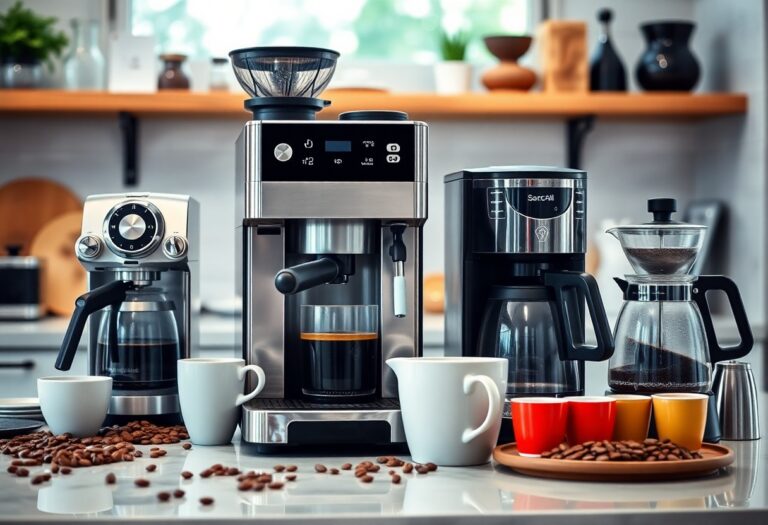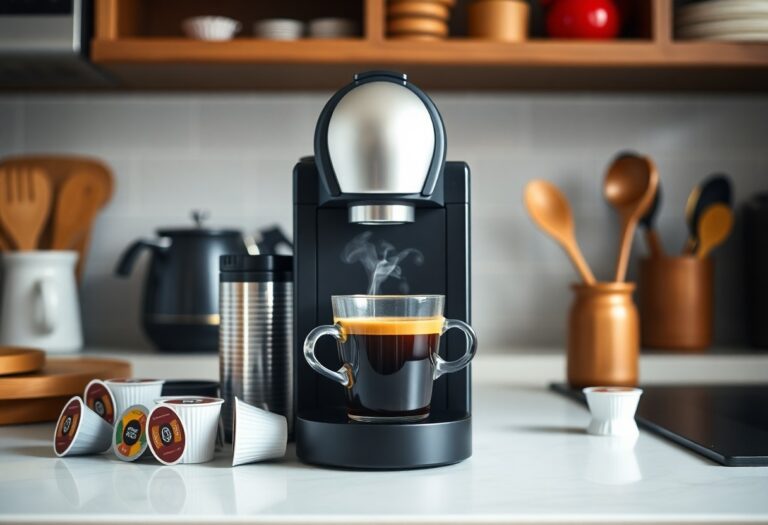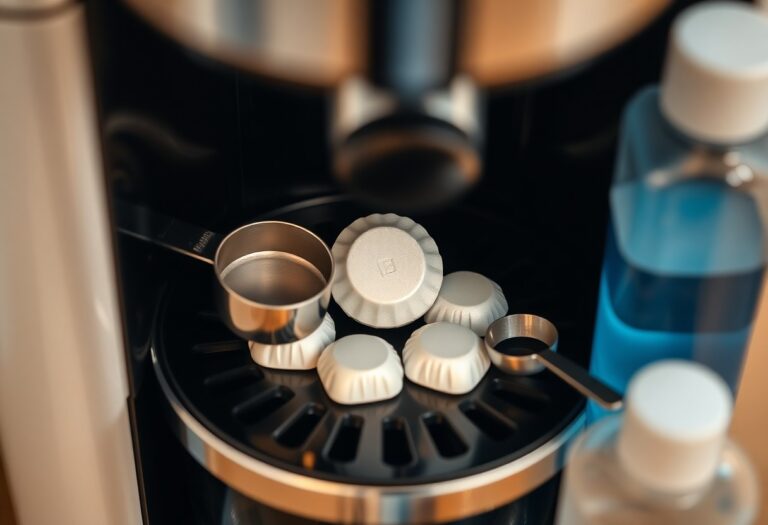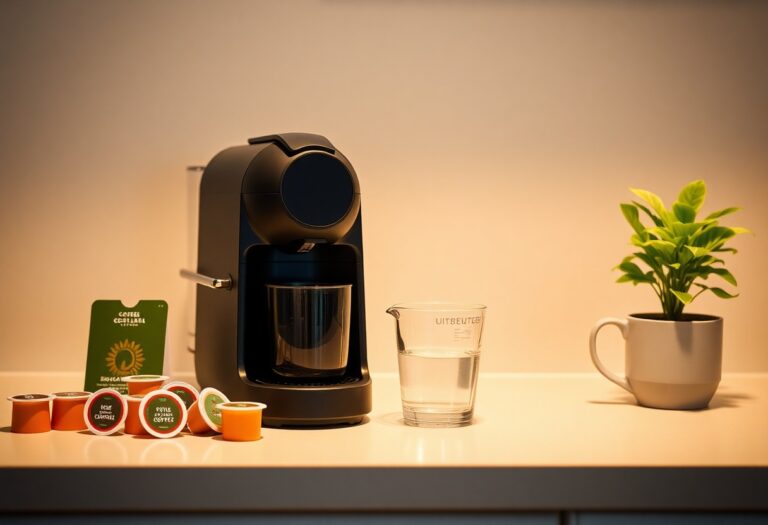What is a Filter Coffee Machine – Drip Brewing System
Over the years, you may have come across the term ‘filter coffee machine’ or ‘drip brewing system’ but might not fully understand its inner workings. This machine offers a convenient way to brew delicious coffee, using a process where hot water drips through coffee grounds, extracting rich flavors. With numerous options available, recognizing the benefits of a filter coffee machine can enhance your coffee experience, but be aware of potential drawbacks, such as maintenance and brewing time. In this post, you’ll discover how these machines can elevate your daily brew.
Key Takeaways:
- A filter coffee machine uses a drip brewing system to create coffee by dripping hot water through coffee grounds.
- The process involves a water reservoir, a heating element, and a coffee basket where the ground coffee is placed.
- This method typically produces a balanced flavor and allows for large quantities of coffee to be brewed at once.
- Most filter coffee machines come with features like programmable timers and automatic shut-off for convenience.
- Regular cleaning and maintenance are important to ensure the machine functions well and to enhance flavor quality.

The Magic Behind Drip Brewing
The allure of drip brewing lies in its simplicity and efficiency. This method extracts the coffee’s crucial flavors and aromas through a gentle infusion of hot water, resulting in a well-balanced cup. As the water trickles through the coffee grounds, it absorbs oils and soluble compounds, yielding not just caffeine but a symphony of rich flavors that can delight your senses. The consistency of the water temperature and flow rate plays a vital role in ensuring uniform extraction, allowing you to enjoy a cup of coffee that showcases the nuances of your chosen beans.
The Mechanics of a Filter Coffee Machine
A filter coffee machine operates on a straightforward mechanism that involves specific stages: heating water, dripping it over coffee grounds, and collecting the brewed coffee below. The process begins when water is heated to the ideal temperature, after which it is funneled through a brew basket filled with coffee grounds. Eventually, the brewed coffee drips down into a carafe or pot for your enjoyment.
Key Components and Their Roles
Several key components work in harmony within a filter coffee machine to deliver your perfect cup. The water reservoir holds the water until needed, while the heating element ensures that it reaches the optimal brewing temperature. The brew basket contains the coffee grounds and often features a filter, while the carafe collects the brewed coffee, ready for serving. Each component’s efficiency contributes to the overall flavor and quality of your coffee experience.
In more detail, the water reservoir is typically removable for easy filling and cleaning, while the heating element is designed to maintain precise temperatures, often ranging from 195°F to 205°F for optimal extraction. The brew basket can accommodate paper or reusable filters, affecting clarity and richness in flavor, and the carafe, often made from glass or thermal materials, keeps your coffee warm while highlighting its appealing color. Together, these components ensure your coffee routine is both reliable and enjoyable, showcasing the intricate dance of technology and flavor extraction. Each part plays a significant role that ultimately influences your daily coffee experience.

The Art of Selecting Coffee
Selecting the right coffee is not just a matter of personal preference; it’s an art that can elevate your brewing experience. Understanding where your coffee comes from, the processing methods used, and the roast profile enables you to find the beans that best suit your palate. Each cup holds the potential for rich taste, and taking the time to explore various options can lead to delightful discoveries.
Coffee Bean Varieties and Their Flavors
Different coffee bean varieties bring unique flavor profiles to your cup. For instance, Arabica beans tend to offer a gentle, sweet flavor with hints of fruit, while Robusta delivers a bolder, earthier taste with higher caffeine content. Choose the variety that resonates with your taste buds, and you’ll be rewarded with a coffee experience that suits your preferences.
Importance of Grind Size and Freshness
The grind size of your coffee significantly impacts the extraction process and overall flavor. Freshly ground beans preserve vital oils, ensuring a vibrant taste. For drip brewing, aim for a medium grind, as it allows water to flow evenly while facilitating optimal extraction.
Using a consistent grind size plays a pivotal role in the brewing process. A medium grind is ideal for drip coffee because it balances the contact time and water flow, resulting in a well-extracted brew. On the other hand, using stale coffee can diminish flavor and aroma, leading to a dull cup. Freshly ground coffee releases aromatic compounds that add depth, enhancing the overall drinking experience. Aim to grind just before brewing to enjoy the maximum potential of your chosen beans; freshness transforms an ordinary cup into something extraordinary.
Brewing Techniques for Perfect Coffee
To achieve the best flavor from your filter coffee machine, mastering brewing techniques is necessary. Pay close attention to the grind size, water-to-coffee ratio, and brewing time to coax out the rich flavors locked within the beans. Each factor plays a significant role in the extraction process. For a comprehensive breakdown of drip coffee specifics, check out What is Drip Coffee – The Complete Guide 2020.
Water Temperature and Quality Considerations
Water quality and temperature can drastically affect your coffee’s flavor profile. Optimal brewing temperature ranges from 195°F to 205°F to achieve balanced extraction without bitterness. Use filtered water to eliminate impurities that could alter the taste. Here’s a quick reference:
| Temperature | Impact on Coffee |
|---|---|
| Below 195°F | Under-extraction, leading to sour flavors. |
| 195°F – 205°F | Optimal extraction, bright and balanced taste. |
| Above 205°F | Over-extraction, resulting in bitter notes. |
Timing: Finding the Sweet Spot
Nailing the timing of your brew can significantly improve your coffee experience. A typical brew cycle in a filter coffee machine lasts anywhere from 4 to 6 minutes. This duration allows proper extraction of flavors without over-extracting, which can introduce undesirable bitterness.
Experimenting with time can yield rewarding results. Aim for the 4-minute mark as a baseline; if your brew tastes flat or underwhelming, extend the extraction by an additional minute or so. Conversely, if bitterness creeps in, shorten the brew time. Documenting these variables allows you to find the sweet spot that best suits your palate, enhancing your coffee enjoyment significantly.
Common Missteps in Drip Brewing
When using a drip brewing system, many enthusiasts unknowingly commit errors that can compromise their coffee’s flavor. Over-grinding your coffee beans or using stale coffee can lead to bitterness, while insufficient water temperature may produce weak, under-extracted brews. Additionally, neglecting the importance of ratios can result in a lackluster cup. Being aware of these missteps is key to enjoying the rich, aromatic benefits of filter coffee.
Overcoming Brewing Myths
Misinformation about brewing methods can also lead to disappointing results. For example, the belief that hotter water equals stronger coffee is misleading. Instead, using the right temperature range of 195°F to 205°F ensures optimal extraction. You might encounter other myths too; understanding the science behind brewing helps demystify these misconceptions and leads to better coffee experiences.
Tips for Trouble-Free Brewing
For a seamless brewing process, employing simple yet effective tips can make all the difference. Start with fresh, coarsely ground coffee beans to ensure full flavor extraction. Maintain your coffee machine by cleaning it regularly, and follow the manufacturer’s recommended brewing guidelines. Use a kitchen scale for accurate measurements of coffee and water, ensuring the perfect strength each time. Assume that with these steps, you can avoid common pitfalls and enjoy consistently great filter coffee.
- Utilize fresh coffee beans for best flavor.
- Adhere to cleaning practices for maintenance.
- Implement accurate measurements for consistent results.
- Ensure water is within the ideal temperature range.
- Check the grind size for optimal extraction.
In addition to these guidelines, consider experimenting with different brewing times to fine-tune your coffee’s strength and flavor profile. The drip brewing process often allows for variability, giving you room to play. If you find your coffee tastes too bitter, try shortening the brew time. Conversely, if it’s too weak, extending the process can enhance the overall flavor. Assume that by taking notes on each attempt, you can refine your preferences over time and achieve the perfect cup.
- Explore brewing times to adjust flavor.
- Document your brewing methods for consistency.
- Adjust coffee-to-water ratios as needed.
- Test different for unique taste.
- Consider water quality including filtration.
Elevating Your Coffee Experience
Enhancing your coffee ritual goes beyond choice; it’s about mastering the brewing process. A quality filter coffee machine empowers you to explore flavor profiles through various brewing techniques. By dialling in the right temperature, grind size, and brew time, you can develop a deeper appreciation for coffee’s complexities and aromas, bringing out the best in every cup. With a little experimentation, you’ll unlock a world of nuanced flavors that transform your daily brew into a truly memorable experience.
Customizing Brew Strength and Flavor Profiles
Customizing brew strength allows you to control the ratio of coffee to water, which significantly impacts the flavor and intensity of your cup. By fine-tuning these measurements, you can cater to your unique palate, whether you prefer a robust espresso-like brew or a milder, more delicate taste. Adjusting variables such as the grind size and brew time adds another layer of complexity, enabling you to create a coffee that is perfectly tailored to your preferences.
Pairing Coffee with Food: A Guide
The right coffee can enhance your dining experience by complementing and elevating food flavors. For instance, a bright, fruity Ethiopian coffee pairs beautifully with chocolate desserts, while a bold, nutty Brazilian brew complements roasted meats and hearty dishes. Understanding these pairings allows you to craft a cohesive flavor experience, celebrating both the food and the coffee in harmony.
To create perfect pairings, consider the flavor notes and body of your coffee in relation to the dish. Light-bodied coffees with floral or citrus notes harmonize with lighter fare, such as salads and seafood, while full-bodied coffees with chocolate or caramel undertones enhance richer meals like stews or grilled meats. Experimenting with different combinations can inspire delightful culinary adventures, revealing hidden tastes and bringing new life to your table.
Summing up
So, a filter coffee machine utilizing the drip brewing system offers you a convenient way to brew rich, flavorful coffee with minimal effort. By harnessing the process of water passing through coffee grounds, you’re able to enjoy a consistent and satisfying cup every time. Whether you’re a casual drinker or a coffee enthusiast, investing in one can enhance your morning routine. For more insights on this method, you might want to check out some details on Drip coffee.
FAQ
Q: What is a filter coffee machine and how does it work?
A: A filter coffee machine, often referred to as a drip brewing system, is a device designed to brew coffee by passing hot water through ground coffee contained in a filter. The machine typically consists of a water reservoir, a heating element, a filter basket, and a carafe for collecting the brewed coffee. The process begins when water is heated, then drips onto the coffee grounds in the filter, extracting flavors and oils. The brewed coffee then drips down into the carafe, ready to be served.
Q: What are the benefits of using a filter coffee machine?
A: Using a filter coffee machine offers several advantages. Firstly, it allows for consistent brewing temperatures and times, which can enhance flavor extraction. Secondly, it typically accommodates larger quantities of coffee, making it ideal for brewing multiple cups at once. Additionally, many machines have programmable features, such as automatic start times and brew strength settings, allowing users to customize their coffee experience. Finally, the filter system usually produces a clean cup, as it effectively removes coffee grounds and sediment.
Q: What types of coffee can be brewed with a filter coffee machine?
A: Filter coffee machines are versatile and can brew a variety of coffee styles. While they are primarily designed for standard drip coffee, users can also experiment with different types of coffee beans, including light, medium, and dark roasts. Furthermore, incorporating flavored coffee grounds or adding spices like cinnamon or nutmeg can create unique blends. However, the machine may not be suitable for espresso-style coffee or cold brew without additional accessories.
Q: How do I clean and maintain my filter coffee machine?
A: Proper cleaning and maintenance of a filter coffee machine are necessary for optimal performance and flavor. Regularly washing the carafe and filter basket with warm soapy water is recommended. Moreover, it’s advisable to descale the machine periodically using a vinegar-water solution or a commercial descaling product to remove mineral buildup. Additionally, cleaning the water reservoir and reflective surfaces will help maintain cleanliness and functionality. Always check the manufacturer’s guidelines for specific cleaning instructions.
Q: Are there any special considerations for choosing a filter coffee machine?
A: When deciding on a filter coffee machine, consider factors such as the capacity you need, features like programmable settings, brew strength control, and whether you prefer a model with a thermal carafe for heat retention or a glass carafe for aesthetic appeal. Additionally, look for machines with easy-to-clean designs and durable construction. Reading user reviews and checking for warranty details can also guide your choice, ensuring you get a machine that meets your preferences and lifestyle.







